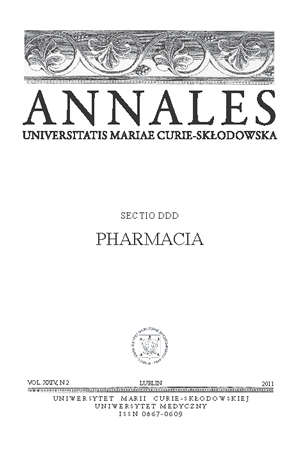The influence of starch hydrolysates on properties of emulsions
Keywords:
starch hydrolysate, density, dynamic viscosity of emulsion, drug release, progesteroneAbstract
The purpose of this study was to investigate the influence of starch hydrolysates on properties of emulsions. Prepared emulsions E01 – E05 with progesterone, as the model drug, were examined for physical and chemical tests. The addition of 20 % SH2 or SH4 considerably increased stability of emulsions (0.54 cm/day and 0.27 cm/day respectively). Drug release test according to extraction method was conduct during 24 hours. The used ethanol in acceptor medium increased amounts of the released progesterone.
References
1. Amani A. et al.: Evaluation of a nanoemulsion – based formulation for respiratory delivery of budesonide by nebulizers. Am. Ass. Pharm. Sci., 10, 1208, 2010.
2. Chorny M. et al.: Study the drug release mechanism from tyrphostin AG-1295-loaded nonospheres by in situ and external sink methods. J. Cont. Release, 83, 401, 2002.
3. Czarnecki W. Belniak P.: Sposób otrzymywania krótkołańcuchowego polisacharydu. Biuletyn Urz. Patent., 4, 13, 2007.
4. Kajita M. et al: Enhanced enteral bioavailability of vancomycin using water-in-oil-in-water multiple emulsion incorporating highly purified unsaturated fatty acid. J. Pharm. Sci., 89, 1234, 2000.
5. Martin A. editor (1969): Physical pharmacy. Lea & Febiger Phyladelphia; p. 519.
6. Mitra R. et al.: Lipid emulsions as vehicles for enhanced nasal delivery of insulin. Int. J. Pharm., 205, 127, 2000.
7. Özer Ö. et al.: W/O/W multiple emulsions containing nitroimidazole derivates for vaginal delivery. Drug Delivery, 14, 139, 2007.
8. Pao-Chu Wu et al.: The effect of component of microemulsion for transdermal delivery of nicardipine hydrochloride. Drug Dev. Ind. Pharm., 36, 1398, 2010.
9. Polish Pharmacopeia, 8th edition, Warsaw 2008.
10. Subramanian B. et al.: Enhancement of anti-inflammatory property of aspirin in mice by a nano-emulsion preparation. Int. Immunopharm., 8, 1533, 2008.
11. Turner-Lawrence D., Kerns II W.: Intravenous fat emulsion: a potential novel antidote. J. Med. Tox., 4, 109, 2008.
12. Uno T. et al.: Pharmacokinetic advantages of a newly developed tacrolimus oil-in-water-type emulsion via the eternal route. Lipids, 34, 249, 1999.
13. Zurowska-Pryczkowska K. et al: Studies on the effect of pilocarpine incorporation into a submicron emulsion on the stability of the drug and the vehicle. Eur. J. Pharm. Biopharm., 47, 255, 1999.
Downloads
Published
Issue
Section
License
Copyright (c) 2011 Authors

This work is licensed under a Creative Commons Attribution-NonCommercial-NoDerivatives 3.0 Unported License.


